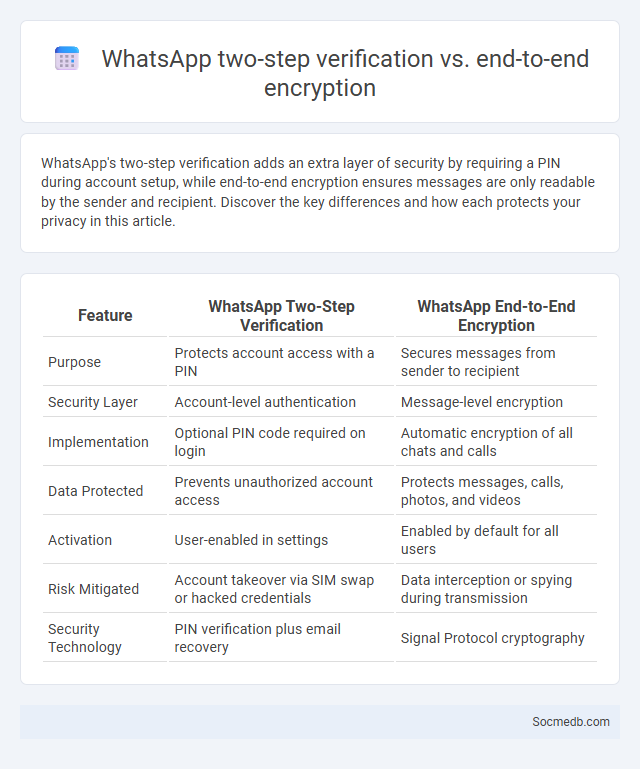
Photo illustration: WhatsApp Two-step verification vs End-to-end encryption
WhatsApp's two-step verification adds an extra layer of security by requiring a PIN during account setup, while end-to-end encryption ensures messages are only readable by the sender and recipient. Discover the key differences and how each protects your privacy in this article.
Table of Comparison
| Feature | WhatsApp Two-Step Verification | WhatsApp End-to-End Encryption |
|---|---|---|
| Purpose | Protects account access with a PIN | Secures messages from sender to recipient |
| Security Layer | Account-level authentication | Message-level encryption |
| Implementation | Optional PIN code required on login | Automatic encryption of all chats and calls |
| Data Protected | Prevents unauthorized account access | Protects messages, calls, photos, and videos |
| Activation | User-enabled in settings | Enabled by default for all users |
| Risk Mitigated | Account takeover via SIM swap or hacked credentials | Data interception or spying during transmission |
| Security Technology | PIN verification plus email recovery | Signal Protocol cryptography |
Introduction: Understanding WhatsApp Security Features
WhatsApp security features include end-to-end encryption, ensuring that only the sender and receiver can read messages, which protects user privacy from potential interception. Two-step verification adds an extra layer of security by requiring a PIN when registering a phone number with WhatsApp. Regular security notifications alert users to any suspicious login attempts or changes to security settings, reinforcing account protection on the platform.
What is WhatsApp Two-Step Verification?
WhatsApp Two-Step Verification is an enhanced security feature that requires you to enter a six-digit PIN in addition to your regular verification code during account setup or device changes. This extra layer of protection helps prevent unauthorized access by ensuring that only you can verify your phone number on WhatsApp. Enabling this feature safeguards your private conversations and personal data from potential breaches.
What is WhatsApp End-to-End Encryption?
WhatsApp End-to-End Encryption is a security feature that ensures messages, calls, photos, and videos are encrypted on the sender's device and only decrypted on the recipient's device, preventing any third party, including WhatsApp itself, from accessing the content. This encryption uses the Signal Protocol, which secures data with unique cryptographic keys for every message, maintaining privacy and confidentiality in real-time communication. With over 2 billion users worldwide, WhatsApp's end-to-end encryption is a critical component in protecting personal information from cyber threats and unauthorized access.
Two-Step Verification: How Does it Work on WhatsApp?
Two-Step Verification on WhatsApp adds an extra layer of security by requiring a six-digit PIN in addition to the regular SMS verification code during login attempts. This feature protects user accounts from unauthorized access by making it difficult for attackers to gain control without the unique PIN set by the user. Users can enable Two-Step Verification through WhatsApp's security settings, and it also allows optional email registration to reset the PIN if forgotten.
End-to-End Encryption: How Does it Protect Your Messages?
End-to-end encryption secures social media messages by encoding the content so only the sender and recipient can read it, preventing intermediaries from accessing the information. This encryption uses cryptographic keys stored solely on users' devices, ensuring message privacy even against platform providers and hackers. Popular platforms like WhatsApp and Signal implement robust end-to-end encryption protocols, significantly enhancing user confidentiality and data protection.
WhatsApp Security: Two-Step Verification vs End-to-End Encryption
WhatsApp employs both two-step verification and end-to-end encryption to enhance your account security and message privacy. Two-step verification requires a PIN to access your account, preventing unauthorized logins, while end-to-end encryption ensures that only you and your recipients can read the messages, blocking any third-party interception. Combining these features significantly strengthens the protection of your personal conversations and sensitive data on the platform.
Key Differences Between Two-Step Verification and End-to-End Encryption
Two-step verification enhances social media account security by requiring users to provide two forms of identification, such as a password and a temporary code, reducing unauthorized access risks. End-to-end encryption protects the content of messages by ensuring only the communicating users can read the data, preventing intermediaries like social media platforms from accessing private information. While two-step verification focuses on user authentication, end-to-end encryption safeguards message confidentiality throughout transmission.
The Importance of Enabling Two-Step Verification on WhatsApp
Enabling two-step verification on WhatsApp significantly enhances your account security by requiring a secondary authentication code beyond just your password, making unauthorized access far more difficult for hackers. This proactive security measure protects your personal data, messages, and contacts from potential breaches while preserving your privacy in an increasingly vulnerable digital environment. By activating two-step verification, you ensure a stronger defense against account hijacking and maintain safer communication across your social media interactions.
Common Myths About WhatsApp Security Features
WhatsApp's end-to-end encryption is often misunderstood, with many users believing it provides complete immunity against all types of cyber threats, while it actually secures message content but not metadata such as timestamps or user locations. Another common myth is that WhatsApp messages cannot be intercepted if a user's device is compromised, but malware or phishing attacks can still expose conversations. Users also frequently assume that privacy settings control all data sharing, overlooking WhatsApp's integration with Facebook's broader data ecosystem, which may lead to data being used for personalized ads and analytics.
Which is More Secure: Two-Step Verification or End-to-End Encryption?
Two-step verification enhances social media security by requiring users to confirm their identity through a second factor, such as a text message or authentication app, reducing the risk of unauthorized access. End-to-end encryption protects message content by ensuring only the communicating users can read the data, preventing interception by third parties or service providers. Security effectiveness depends on context: two-step verification secures account access, while end-to-end encryption safeguards message privacy.
 socmedb.com
socmedb.com